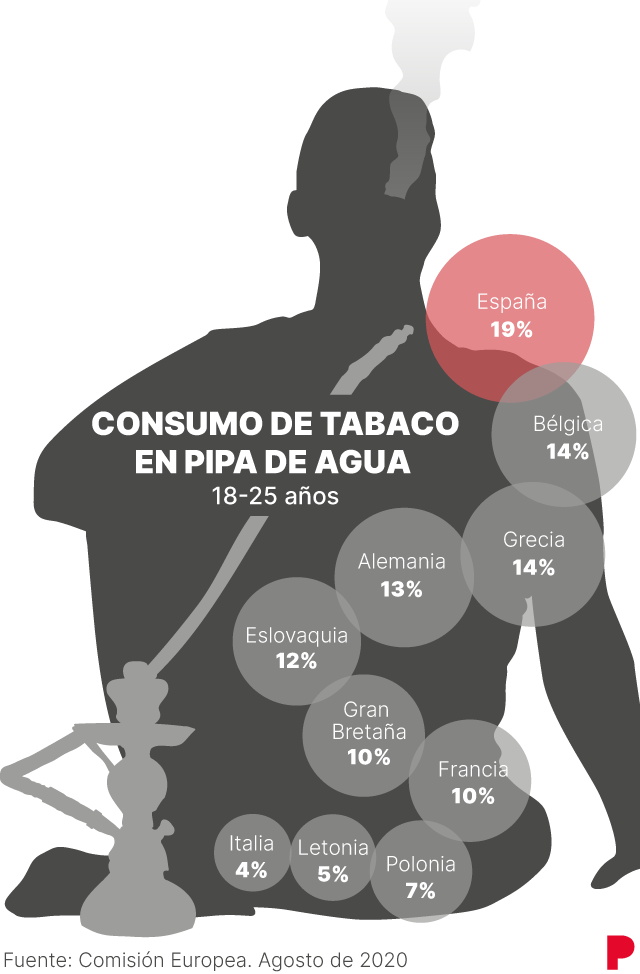-
Spain is the European country with the most people between the ages of 18 and 25 who smoke waterpipe tobacco: one in five uses it
The aroma of strawberry and vanilla permeates the street several meters from the premises. Once inside, the dim lighting and masked waiters stroll through the dense smoke that swirls around the tables, mostly occupied by young people who take turns sipping from the pipe of the hookahs or ‘sishas’, the new product. star. Although it has been more than 16 years since the consumption of tobacco is allowed inside bars, hookahs escape the ban. The business has proliferated among the youngest, and there are more and more places that include in their menu tastings of a product as toxic as cigarettes that were expelled from the interiors because of the legislation.
In Spain, one in five young people uses waterpipe tobacco, the highest percentage among European neighbors. And the main problem is the reasons why they choose this type of product: they consider it less harmful. It is the result of a study led by the Open University of Catalonia (UOC) that analyzes the perceptions of consumers from nine EU countries and the United Kingdom about tobacco products. “It confirms something that we already observed: that the consumption of this type of tobacco has grown. What is surprising is that the perception of health risk is much lower, and that is what is worrying & rdquor ;, indicates the researcher Francisco Lupiáñez, who has led the project. This is influenced by its strong social character, linked to consumption in bars, cafes and even discos. And the lack of regulation.

Although waterpipe tobacco is included in law 28/2005 on sanitary measures against smoking, smoking products based on aromatic herbs and that do not contain tobacco are governed by a decree of 2017 that does not say anything about their consumption . Is the legal loophole used by some hoteliers: hookahs are allowed inside bars as long as the product being smoked does not contain tobacco, but the reality is that these nicotine-free aromatic herbs are not the ones that end up being consumed.
According to data from the Ministry of Finance on the Tobacco Market, in 2010 400,000 kilos of pipe tobacco were sold – not just water. In 2020 it was almost two million. Seville hosted this year the HookaFair, the most important fair in the world for products of shisha, which was announced stating that “the Spanish market is recognized as one of the most prominent in the world & rdquor ;. And on Instagram there are already more than a thousand influencers who promote the consumption of hookah. “There are watermelon, melon & mldr; This for young people is very attractive. They think ‘something that smells like fruit, it won’t be so bad’ & rdquor; Andres Zamorano, president of the National Committee for Smoking Prevention.
Harmful, with or without nicotine
“A typical session smoking a ‘shisha’ equates to smoking up to 50 cigarettes& rdquor ;, denounces Zamorano, who recalls that “the water does not filter absolutely anything, it is part of the optical illusion of the hookah & rdquor ;. And that characteristic white haze has the same high levels of carbon dioxide, heavy metals and carcinogens as that of a cigarette.
In addition, those who smoke in ‘shisha’ are exposed to toxic substances both from tobacco and from the coal used to heat it. And there are also passive smokers: the smoke is harmful even for those who are not inhaling it. Sitting in a place and asking for a water pipe allows smoking without having to read the messages on the packs that warn about its dangers. The famous “smoking kills & rdquor; it is visible only to the waiters unpacking it. “This is outrageous,” Zamorano insists.
During the pandemic, the WHO warned that smoking in a water pipe could increase the risk of spreading covid by consuming it in a group and by sharing nozzles and hoses. Sanitation recommended avoid the use of tobacco “and related products & rdquor; in hospitality spaces and, specifically, “eliminate the sharing of water pipes & rdquor ;. But the places where consumption is allowed continue to proliferate, especially in those communities that have not specifically prohibited them.
Zamorano points to the premises that “normalize & rdquor; with the ‘shisha’s the fact of smoking. “What the Police even told us is that when they arrive at one of these establishments, they are told that what they are using is herbs and not tobacco, and the agents have to check it. In some territories, specific Civil Guard operations have been carried out to control the consumption of hookahs in bars and clubs that have resulted in hundreds of complaints and fines.
Related news
A European regulation
The European directive on tobacco is now under review. “We launched this study because of the concern of the European authorities about this type of products that escape the legislation, are on the rise and have an impact on public health and the single European market,” explains Lupiáñez. “There are products that were available in some countries and not in others, there was no single regulation on the subject& rdquor ;, adds. The researcher recalls the controversy that aroused in Europe about the use of electronic cigarettes. The United Kingdom opted to use it as a tool to reduce the consumption of traditional tobacco, but other countries, including Spain, opposed it because in the medium term it would be just as harmful. “The Commission can give an umbrella so that this type of controversy does not exist & rdquor ;, he explains.
Reference-www.elperiodico.com